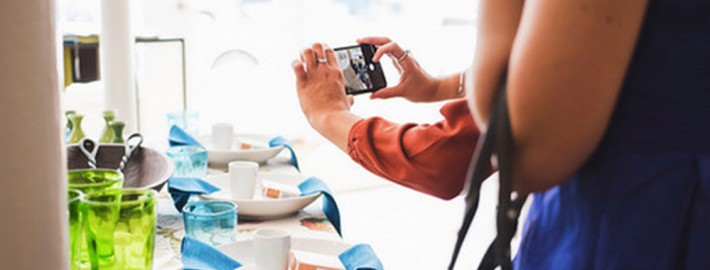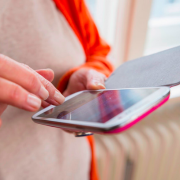9 ways mobile and social tech improves the retail shopping experience
Retail and e-commerce experts share their tips on how malls and stores can enhance the in-store shopping experience with mobile and social media technology.
(This an excellent retail check list for effective mobile engagement.)
With the continued growth of ecommerce and in-store comparison-shopping via mobile devices, it’s become harder for many bricks-and-mortar retailers to get customers to make on-the-spot purchases. However, instead of seeing mobile and e-commerce as a threat, some savvy retailers have embraced the adage “if you can’t beat them, join them.”
So how are these bricks-and-mortar retailers using mobile and social apps to their advantage – and what can you do to keep consumers from going elsewhere to shop? Follow these nine suggestions to make the sale.
“Retailers should look to deploy secure public wireless networks that support consumer apps that drive engagement with mobile shoppers,” says Greg Griffiths, vice president, product marketing, EarthLink, which provides managed network, security and cloud solutions for multi-location retail and service businesses. Using Wi-Fi and beacons, “retailers can interact with mobile shoppers while gathering information on who’s in the store and how long they stay to learn more about shopping patterns.”
Moreover, “a recent IHL Group study showed [that] retailers [that] deployed in-store Wi-Fi report[ed] increased customer loyalty since deploying the technology,” he notes.
2. Station self-service kiosks around the store.
Not every customer has or wants to use her mobile device when in a store, which is why retailers should consider self-service kiosks.
“In-store kiosks that integrate with the [retailer’s] point of sale system and online store can show customers what options are available online and in store, and even direct them to where they [can find items] within the store,” says Andrew Van Noy, CEO, Warp 9, digital commerce, mobile and security experts. “In addition, these integrated kiosks could make product recommendations that may have not been previously considered.”
3. Showcase user-generated content next to products.
“Bazaarvoice research shows that mobile shoppers who view consumer-generated content [have a] 133 percent higher conversion rate,” says Lucas Tieleman, director of in-store product innovation at Bazaarvoice, which provides user-generated content marketing solutions. “Using a mobile phone’s geolocation features and beacon technology, brands can push relevant product reviews to a consumer’s device in their exact moment of need, enabling the consumer to read reviews from likeminded shoppers and make a more informed purchase decision.”
Similarly, “retailers can take a page from the Target and Macy’s playbooks and draw attention in store to items that have been featured or highly popular on Pinterest [or Instagram],” says Michelle Stinson Ross, who handles social media outreach at AuthorityLabs, which provides search engine rank monitoring software. “Take it a step further with pins that demonstrate how a product can be used.” For example, “a cake pan can be featured in a creative summer recipe. A scarf can be featured as a way to change up several outfits.”
4. Create a branded retail mobile app that can be used in store to provide shoppers better service.
“When a shopper enters a physical store, encourage them to launch a branded app to see available loyalty credits, view products they tagged as favorites and get suggestions on products based on their profile and past purchases,” suggests Tom Redd, global vice president, strategic communications, SAP. “This connects shoppers with products matched to their preferences, and helps them find new products to complement ones they already own. This is highly effective in fashion, but also tools, electronics and housewares,” he says. “After purchase, shoppers can use the app to post purchases to social sites for extended marketing reach.”
“Retail mobile apps allow customers to opt-in to sharing personal information in exchange for receiving more knowledgeable customer service,” says Alison Clark, product manager, RhoMobile, an enterprise app development platform. For example, “Neiman Marcus is finding success with its NM app, [which provides] store associates with information like a customer’s shopping history, product preferences, location and Facebook profile image,” she notes. “Associates can then locate and greet customers in store, and provide smartly tailored offers and product recommendations.”
5. Offer mobile coupons to customers while they are shopping.
“Shoppers [often] forget they have mobile coupons while they are in a store aisle,” says Liz Crawford, senior vice president, Insights & Strategy, and head of ShopLab, a division of Match Marketing Group. However, apps like “Target’s cartwheel have successfully overcome this issue.” Target shoppers unaware of sales or promotions “can grab a discount on the spot by scanning a code on the endcap at Target stores [with cartwheel],” she explains. Then “the shopper’s cartwheel account code is shown, via smartphone, at checkout.”
Another popular in-store rewards and deals app is shopkick, whose retail partners include Macy’s, Target, Best Buy, JCPenney, Kraft, Unilever, P&G and many others.
“It is a seamless experience as consumers are used to communicating via SMS,” says Adam Meshekow, executive vice president, Product Strategy & National Sales, SITO Mobile. “If a shopper was shopping in a grocery store and they saw they could get $5 off if they buy 4 or more Unilever products, it can entice a larger basket size and give value to the consumer.”
6. Give in-store discounts for social media promotion. “One way to integrate your social strategy into shopping is to give customers an in-store incentive for interacting with your brand digitally,” says Evan James, head of North American marketing at social media analytics company Socialbakers. For example, “offer in-store customers a discount on a product if they take a desired action on Facebook or send a tweet with a certain hashtag. That way, you’re using social to increase the word of mouth around your product to other potential customers while also boosting your in-store sales at the same time.”
“Offer a small discount to anyone who uses the check in function on Facebook,” suggests Graeme Watt, online strategy manager, The Zen Agency. “The check-in will be visible to the friends of the person who is checking in, giving your business additional exposure for relatively little cost.”
“We ask our customers to check in on Facebook with their purchase for a free sample,” says Krista Dolash, owner, Root, a maker of natural and organic beauty products. “It has created a local buzz about our business and converted so many of our customers to purchase full sizes of the samples we’ve given them. It’s a double win!”
7. Use apps to make in-store shopping more fun. “Add a layer of excitement [to in-store shopping] by providing an experience, like a scavenger hunt, games and contests,” suggests Alex Muller, CEO, GPShopper, an integrated mobile platform for retailers and brands.
Similarly, allow “customers [to] earn points, unlock rewards and share scanned items over social media as they shop,” says Samuel Mueller, CEO, Scandit, which provides mobile barcode scanning solutions for smartphones, tablets and wearable devices. Customers will enjoy the in-store shopping experience more “while retailers [will] benefit from increased brand loyalty and enhanced community engagement.”
“To make shopping easier and more entertaining for families with small children, British shoe retailer Clarks recently rolled out an interactive, iPad-based system for measuring children’s shoe sizes,” says Tom Karren, cofounder & CEO, Moki, which provides device management, security and analytics. The app “creates an engaging heat sensor image of the child’s foot, making the process of trying on new shoes more appealing to children and easier for parents.”
8. Use mobile technology to make trying on clothes easier. “Arm your store associates with tablets and offer an Assist Me feature in your app,” suggests Muller. “This allows shoppers in the dressing room to summon help from your in-store staff when they’d like to try an alternate color or size.”
“If you make a customer put their clothes back on to go out and find a different size/color, and then have to wait in line again for an available room, or if you make them awkwardly yell to a sales assistant that they need help, you are decreasing the likelihood of a sale,” adds Van Noy. However, “if retailers implemented Smart Dressing Rooms, [where] customers could request products from a sales associate from a tablet,” you’re more likely to keep the customer engaged and make the sale.
9. Give shoppers a mobile checkout option. “Many retailers are developing apps that allow shoppers to browse, scan and buy products on their phone, there[by] skipping the always dreaded long checkout lines,” says Laura Swanson, senior consultant at FitForCommerce, an omnichannel consulting firm that helps retailers define and execute growth strategies and select technologies. “This is especially popular in grocery stores where the convenience of popping into the store for a few grocery items is typically hindered by a long line.”
“By empowering customers to scan items as they shop and effortlessly check out, retailers ensure customers experience shorter lines and abandon fewer items,” says Mueller. “Retailers are also able to reduce the number of traditional checkout stations required, reducing operational costs. With fewer traditional checkout stations, retailers can reserve valuable front-of-store real estate for product showcases.”
About ARworks Middle-East
ARworks Middle East is leading provider of strategic and innovative Mobile engagement solutions. Headquartered in Dubai, we’re part of ARworks Global, which has offices across Europe and the USA. We’ve been at the forefront of the industry since our launch in 2011, seamlessly blurring the lines between the physical and the digital, creating award-winning, innovative mobile applications that deliver strategic solutions to enhance business and marketing objectives.





